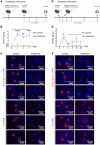Adeno-associated virus-based gene therapy treats inflammatory kidney disease in mice
- PMID: 39225099
- PMCID: PMC11364381
- DOI: 10.1172/JCI174722
Adeno-associated virus-based gene therapy treats inflammatory kidney disease in mice
Abstract
Adeno-associated virus (AAV) is a promising in vivo gene delivery platform showing advantages in delivering therapeutic molecules to difficult or undruggable cells. However, natural AAV serotypes have insufficient transduction specificity and efficiency in kidney cells. Here, we developed an evolution-directed selection protocol for renal glomeruli and identified what we believe to be a new vector termed AAV2-GEC that specifically and efficiently targets the glomerular endothelial cells (GEC) after systemic administration and maintains robust GEC tropism in healthy and diseased rodents. AAV2-GEC-mediated delivery of IdeS, a bacterial antibody-cleaving proteinase, provided sustained clearance of kidney-bound antibodies and successfully treated antiglomerular basement membrane glomerulonephritis in mice. Taken together, this study showcases the potential of AAV as a gene delivery platform for challenging cell types. The development of AAV2-GEC and its successful application in the treatment of antibody-mediated kidney disease represents a significant step forward and opens up promising avenues for kidney medicine.
Keywords: Autoimmune diseases; Endothelial cells; Gene therapy; Nephrology; Therapeutics.
Figures





References
MeSH terms
LinkOut - more resources
Full Text Sources
Medical

